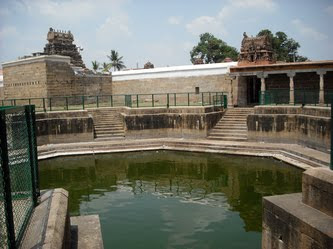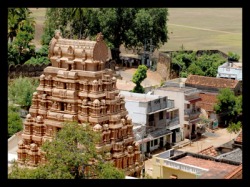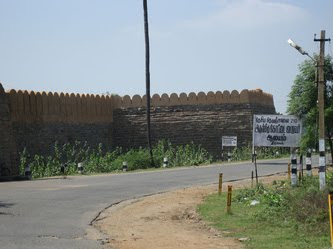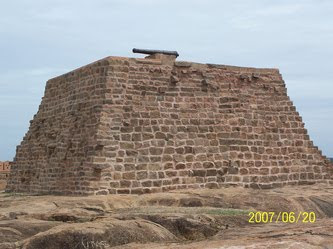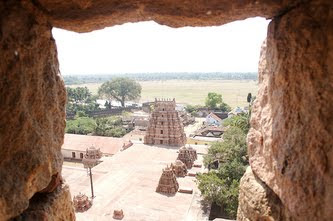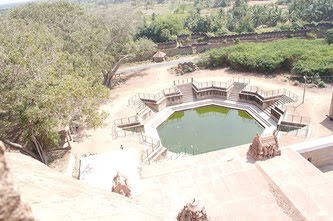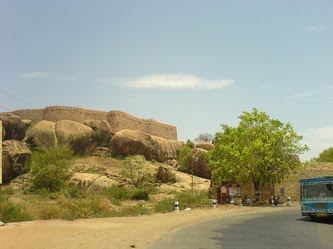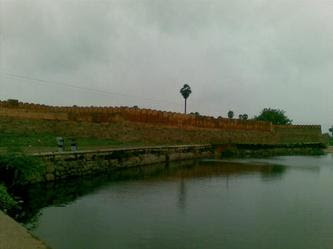
Chronologically, Korkai is the oldest port site of Tamil country possibly since the
beginning of the first millennium BC. However, its emergence as a significant
emporium may have been only around the fourth and fifth century BC. Korkai
(8°40¢N; 78°5¢E) is recognized by the Periplus of the Erythrean Sea as Colchis
and by Ptolemy as Kolkhoi. Correct indentification came in 1838. Early archaeological
excavations carried out by Caldwell in the Tamiraparani delta in the 19th century,
affirmed its present site almost in ruins close to a place called Eral1. It was
a dual centre of the early Pandya rule, identified with Pandya-Kavada by the
Ramayana and the Mahabharat, and as Kapatapuram in Kalithogai. Its reputation
is spoken of in Akananuru and Ainkurunuru. The entire Gulf of Mannar is
recognized by the Periplus as the Colchic Gulf, due to pre-eminent status of Korkai.
Excavations by Nagaswamy and others have brought to light the early artifacts
of the site at Korkai. Stone inscriptions in the Koil of Vetrivelamman and the
Pillayar Kovil at Korkai and at Attur across the river on the opposite bank reaffirm
that the site is the old port of Korkai. A lone ‘Vanni’ tree standing in
Korkai is about 2000 years old, according to the Tamil Nadu Archaeological
Survey.
Upstream of Korkai about 20 km away on the same river valley on the right bank of
Tamiraparani is Aditchanallur, the largest megalithic burial urn area in South
India. Its proximity and the find of megalithic burial urns at Korkai itself indicate
that the valley side was fairly well-populated during megalithic times. Carbon
dating of the artifacts in the area indicates an age of 785 BC, while Aditchanallur
findings of copper finds including an icon of Mother Goddess of 8th century
BC indicate that it was an active settlement, and probably river navigation extended
up to it from the delta mouth. Korkai is sited on an alluvial terrace,
above the present-day flood plain of the river. The archaeological finds are about
3 m below the terrace level. Excavations have revealed Mauryan pottery of 2nd
and 3rd century BC and the glazed pottery found belong to Northern Black Polished
ware. The burial urns lie adjoining a structure built with large bricks. Adjoining
on the west end are heaps of pearl oyster shells, and three ring wells. More
significantly, the finds of black and red pottery ware with old Tamil Brahmi scripts
(two to four letters in a line or two), apart from drawn graffiti of the sun, fish, bow
and arrow have been dated to a period between 3rd century BC and 2nd century
AD. The occurrence of Roman ware, and rouletted ware indicates their external links.
Archeologists have found ruins of chankcutting factories, centres for split opening
phase of the megalithic period and Korkai itself was a major Pandyan port during
this period. Though it continued to function till the 5th century AD, it was on a
decline since the 3rd century AD. Probably with this decline is linked the shift of the
Pandyan capital from Ten-Madurai or Korkai itself to the later capital at
Madurai.
Korkai is located 7.5 km away from the sea, close to Eral. It is on the northern
left bank of Tamiraparani river close to the apex of the bird-foot delta. The agriculturally
productive delta of the river known for abruptly rising flash floods is dynamic
and fast growing out into the sea, due the heavy sedimentation of the river alluvium in
a relatively tideless sea. Palaeo-channels traced from the satellite imagery scenes
all around Korkai indicate that the river has shifted its course progressively east
and south. As can be seen from a scrutiny of the topographic sheets and satellite imagery
and tracking of palaeo-channels, Korkai, once on the sea has receded away from the
shore (Figure 1). The nature of the birdfoot delta, lobes, lagoons, marine terraces,
beach ridges and bars on the sea front, newly formed and old islands have all
helped in tracing the probable stages in the evolution of the delta, as the river course
progressively shifted south, and the distributaries elaborated. The Korkai Bay
in the advancing front of the delta lobe got silted, and the port had to decline. The
siltation is so rapid that in the last 2000 years of the historic past, land has advanced
into the sea over a distance of about 8 km. After the decline of Korkai, Palayakayal
emerged as a new port, but never rose to the prominence of Korkai. The replacement
of Korkai by Kayal might have commenced around the 6th century AD. But its
importance as a major port did not take effect till the 12th century AD. The port
site is at a location called Palayakayal on a northern distributary of the delta, about
5 km northeast of Korkai.
Interpretation of satellite imagery (Figure 2) indicates that in the 1st and 2nd century
AD, the Tamiraparani river might have flowed towards northeast from Eral, parallel
to the coast and joined the sea south of Tuttukudi town. Korampallam tank,
Peykulam, and Arumugamangalam tank might be the relicts of palaeochannel of
the Tamiraparani river. In Tamil, Aru means river and Mugam means face. The name
of the settlement ‘Arumugamangalam’ might have been derived since it was
situated on the bank of the river. At present there is no river in the area, but
there exists a tank, which is elongated in shape, situated parallel to Peykulam, and
Korampallam tanks. This tract has fertile alluvial deposits in a linear pattern. So,
this must be the old river course of the Tamiraparani river. The ancient port Korkai
might have been situated on one of the distributatries of the Tamiraparani close
to the sea coast. About 1 km southwest of Korkai there is a settlement called Kanavisamudram,
indicating presence of sea or extensive water body nearby. There must
have been a bay close to Korkai in the Gulf of Mannar, which would have allowed
more ships to anchor. Due to heavy sedimentation and deposition both by the sea and the river,


as a new port in place of Korkai. Later, the coast might have prograded
towards the east giving rise to new ports like Punnakayal and Kayalpattinam. At
present the coast is about 200 m east of Kayalpattinam.
The Tamiraparani river might have flowed towards north of its present delta
and joined the sea south of Tuttukudi town. Palaeo-channels traced from the satellite
imagery indicate that the Tamiraparani river might have shifted course
progressively from north to south and in the east. The siltation is so rapid and
heavy that in the last 2000 years of the historic past, land has advanced into the
sea over a distance of 7.5 km.











